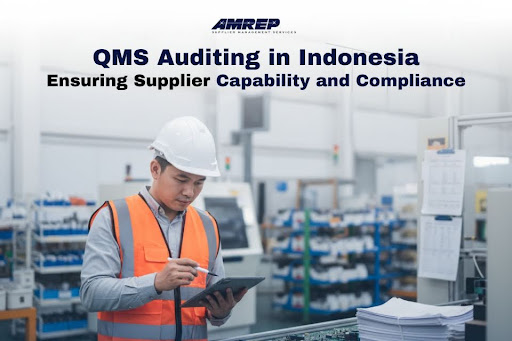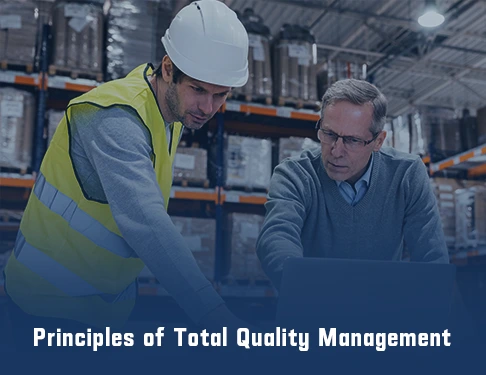Guide to Qualifying New Suppliers in Malaysia for Manufacturing Success
Malaysia is a premier manufacturing hub in Southeast Asia. According to the Malaysian Investment Development Authority (MIDA), “Malaysia, with its extensive trade....
By AMREP | Posted on October 16, 2025
QMS auditing helps suppliers in Indonesia meet global quality requirements and maintain consistent performance. According to Badan Pusat Statistik (BPS) Indonesia, Indonesia’s manufacturing industry continues to grow, with exports reaching US$266.5 billion in 2024, representing a 2.7 percent increase from the previous year. This growth highlights the country’s increasing role in global supply chains and the importance of maintaining consistent quality at every level.
A Quality Management System (QMS) audit allows organizations to evaluate supplier performance, confirm compliance with ISO standards, and identify areas that need improvement. Through structured audits, companies can reduce risks related to product defects, regulatory issues, and delivery failures.
In this article, we explore how QMS auditing in Indonesia supports supplier reliability, compliance, and long-term business success.

A Quality Management System (QMS) audit is a structured process used to evaluate how well an organization’s operations align with established quality standards. It helps determine whether a company’s systems, procedures, and practices consistently meet customer and regulatory requirements.
In Indonesia, QMS audits are commonly guided by international standards such as ISO 9001, which focuses on quality management, ISO 14001 for environmental management, and ISO 45001 for occupational health and safety. These standards provide a framework that ensures suppliers operate efficiently, maintain quality consistency, and comply with both local and global expectations.
There are several types of QMS audits:
By conducting regular QMS audits, businesses can identify weaknesses, improve process control, and promote a culture of continuous improvement. Such practice not only enhances product quality but also strengthens the trust between manufacturers and their clients in Indonesia’s expanding industrial landscape.
Indonesia is emerging as a key manufacturing hub in Southeast Asia, supported by strong growth in the automotive, electronics, and food processing industries. The government promotes quality and competitiveness through national standards managed by the National Standardization Agency (BSN) and the Ministry of Industry. These standards, known as SNI (Standar Nasional Indonesia), are often aligned with international frameworks such as ISO.
Many local suppliers pursue ISO 9001 and related certifications to meet global buyer expectations. However, certification alone does not guarantee consistent quality. Regular QMS audits are necessary to verify that suppliers follow proper systems, maintain documentation, and apply continuous improvement in their operations.
As Indonesia’s manufacturing sector grows, effective QMS auditing helps bridge local regulations with international standards, ensuring supplier reliability and long-term compliance.
Conducting a Quality Management System (QMS) audit in Indonesia requires a structured and methodical approach to ensure suppliers meet both national and international quality standards. A well-planned audit not only identifies areas of non-compliance but also promotes efficiency, accountability, and continuous improvement throughout the supply chain. Before reaching these outcomes, organizations should understand the four main stages of a QMS audit, given below:
The preparation stage establishes the foundation for a smooth and effective audit. It focuses on setting clear goals, selecting qualified auditors, and ensuring both parties understand the expectations. Key activities during preparation include:
This phase involves on-site verification of the supplier’s operations. Auditors collect evidence to confirm that processes, systems, and employee practices align with documented procedures and relevant standards. During execution, auditors typically:
Once the on-site assessment is complete, auditors summarize results in a detailed QMS audit report. This report provides an objective view of supplier performance and highlights areas that need correction or improvement. An effective audit report should:
The follow-up phase ensures that audit findings lead to real, measurable improvement. Suppliers create a Corrective Action Plan (CAP) and work to resolve identified issues within agreed timelines. Strong follow-up processes include:
QMS audits in Indonesia come with distinct challenges. Understanding them helps companies plan effective audits. Below are some of the most common ones.
Communication can be difficult in Indonesia’s multilingual environment.
Although SNI aligns with many ISO principles, key differences still exist.
Many Indonesian suppliers are still developing formal quality systems.
Indonesia’s size and infrastructure can make supplier audits challenging.
To achieve meaningful and lasting results, companies should approach QMS auditing in Indonesia with methods that build trust, ensure consistency, and encourage continuous improvement. The following practices can help make supplier audits more effective and value-driven.
Understanding local culture and communication styles improves the accuracy and openness of audits.
Focusing on high-impact areas allows companies to manage quality and compliance more efficiently.
Digital solutions and quality control tools can make audits faster, more accurate, and easier to manage across multiple locations.
Treating audits as improvement opportunities builds stronger supplier relationships.
The landscape of QMS auditing in Indonesia is evolving rapidly. Organizations are embracing innovation and sustainability to strengthen supplier compliance and long-term quality performance.
Modern quality systems are expanding beyond traditional compliance. Many Indonesian companies are now integrating sustainability, ESG principles, and digital traceability into their QMS frameworks. These efforts help track environmental performance, ensure ethical sourcing, and improve supply chain transparency.
Future audits will place greater emphasis on social and environmental accountability. Auditors are beginning to assess labor conditions, workplace safety, and environmental management as part of their evaluations. This shift supports responsible sourcing and aligns Indonesian manufacturers with global expectations for ethical business practices.
Technology is reshaping how audits are conducted. The use of remote auditing allows companies to evaluate suppliers through digital platforms without the need for on-site visits, saving both time and resources. Meanwhile, AI-based compliance monitoring enables continuous assessment by analyzing process data and detecting quality risks in real time. This combination improves efficiency and supports proactive quality management.
Together, these changes are shaping a new era of auditing that is smarter, more transparent, and focused on sustainable growth.
Strong supplier auditing is the foundation of reliable quality and lasting business success. As Indonesia’s manufacturing sector continues to expand, effective QMS auditing helps companies ensure consistency, compliance, and continuous improvement.
Partnering with experts like AMREP Inspect allows you to ensure supplier compliance with expert QMS auditing services that go beyond surface-level inspections. With extensive experience in supplier quality management and on-site inspections, AMREP Inspect helps businesses identify risks early, enhance supplier performance, and uphold international standards.
Contact AMREP Inspect today to learn how professional QMS auditing can enhance your supplier reliability and support long-term growth.
Contact Us To See What We Can Do
Call Us
Mon - Sat 9.00 - 18.00
Sunday Closed


12 - May 2025
12
May
2025
Malaysia is a premier manufacturing hub in Southeast Asia. According to the Malaysian Investment Development Authority (MIDA), “Malaysia, with its extensive trade....

22 - April 2025
22
April
2025
Healthcare is rapidly evolving, ensuring consistent and high-quality patient care. Total Quality Management (TQM) in healthcare is more than just a buzzword—it is a powerful....

16 - April 2025
16
April
2025
Total Quality Management (TQM) is a mindset that involves everyone in the organization working toward a common goal: achieving excellence through quality. From....
